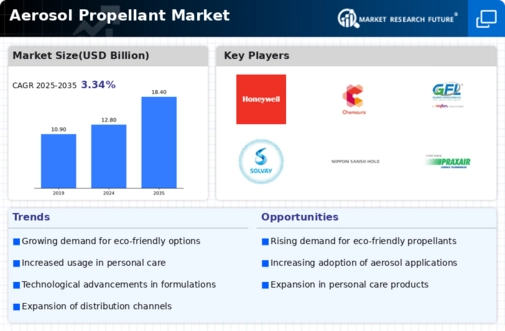Aerosol Propellant Market Summary
The Global Aerosol Propellant Market is projected to grow from 12.79 USD Billion in 2024 to 18.36 USD Billion by 2035.
Key Market Trends & Highlights
Aerosol Propellant Key Trends and Highlights
- The market is expected to experience a compound annual growth rate of 3.34 percent from 2025 to 2035.
- By 2035, the market valuation is anticipated to reach 18.4 USD Billion, indicating robust growth opportunities.
- in 2024, the market is valued at 12.79 USD Billion, reflecting a solid foundation for future expansion.
- Growing adoption of eco-friendly propellants due to increasing environmental regulations is a major market driver.
Market Size & Forecast
| 2024 Market Size | 12.79 (USD Billion) |
| 2035 Market Size | 18.36 (USD Billion) |
| CAGR (2025-2035) | 3.34% |
Major Players
Honeywell, Arkema S.A., The Chemours Company, Air Products and Chemicals, Inc., Gujarat Fluorochemicals Limited, Shinho Chemical, Ltd., Daikin Industries, Ltd., Solvay, Messer Group GmbH, Taiyo Nippon Sanso Corporation, Dyneon LLC, Linde plc, Praxair, Inc., Societe Air Liquide S.A.


















Leave a Comment